#may 11 2020
Photo
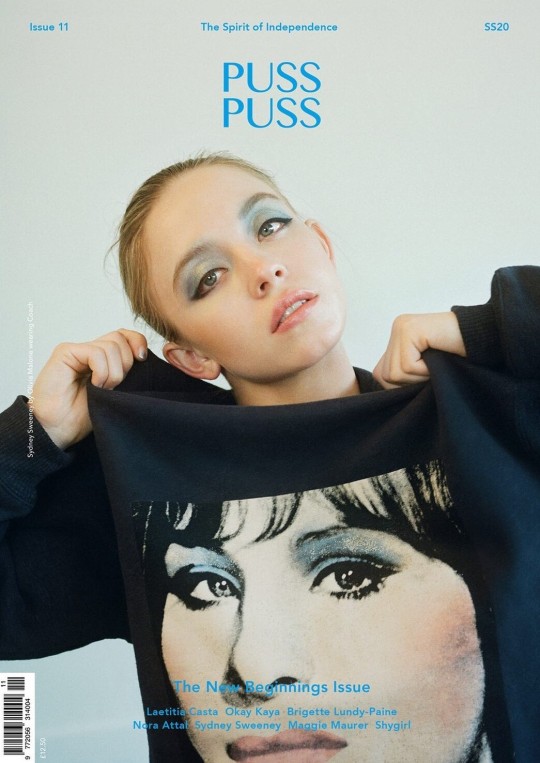
Sydney Sweeney-PUSS PUSS-Issue 11-May 11, 2020
#Sydney Sweeney#Euphoria#The Spirit of Independence#The New Beginnings Issue#PUSS PUSS#Blonde#Cute#May 11 2020#Issue 11#Magazine Cover#Actress
0 notes
Text
Video 📹 from 11 May 2020 Harper’s Bazaar
We Want to Be Caitríona Balfe Reading Poetry on the Beach Right Now
The Outlander actress recites W. B. Yeats in a short film by photographer and director James Houston.
In a new video, Caitríona Balfe is spending her day the way we'd like to be spending our time social distancing: on the beach, alone, reading poetry. The footage of the Outlander star was filmed back in February, months before the concept of quarantines and lockdowns had even crossed our minds, but now, the clip of Balfe in solitude is even more relevant.
The short film was shot by photographer and director James Houston—an old friend and frequent collaborator of Balfe's—in L.A. In it, the actress runs barefoot on the sand, laughing with the wind blowing in her hair.
"Shooting Caitríona is always such a wonderful and rewarding experience," Houston tells BAZAAR.com. "She is a dear friend and a true natural beauty. Even though her star has risen over recent years as a respected actress, she has remained the same grounded and humble girl I met years ago. I loved this shoot of her because it showcases her timeless beauty. I chose to take her to the ocean with minimal styling, hair, and makeup to capture an intimate, raw portrait of her."
In the background, Balfe narrates the poem "He Wishes for the Cloths of Heaven" by W. B. Yeats, which was a collaborative choice made by both the actress and director. "After I directed this piece for Caitríona, I was thinking about what to put behind the visuals," Houston explains. "I know Caitríona is well read and loves poetry, so rather than just use a music track, I asked her to send me a few of her favorite poems. I chose W. B. Yeats as it just felt right for Caitríona and the visuals. After recording her reading the poem (which only took two takes), we added the sounds of the ocean and birds. I really love the result."
Watch the full video above, and read Balfe's interview on last night's Outlander Season 5 finale, featuring more photographs from Houston below.
Harper’s Bazaar
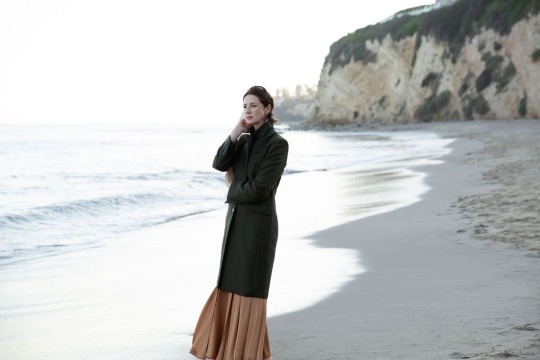

Sweater, Ralph Lauren
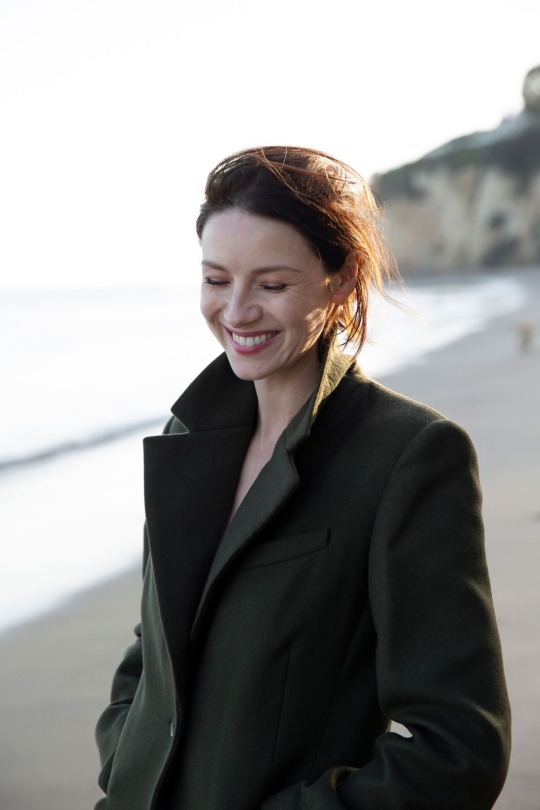
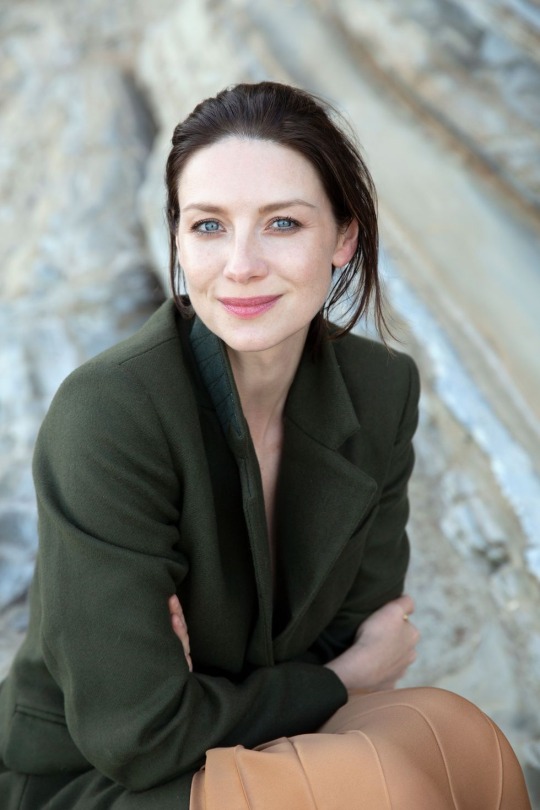
Coat, Aritzia; skirt, The Row
Remember… William Butler Yeats, widely considered one of the greatest poets of the English language, received the 1923 Nobel Prize for Literature. His work was greatly influenced by the heritage and politics of Ireland. — poets.org
#Tait rhymes with hat#Good times#Harper’s Bazaar#11 May 2020#He Wishes for the Cloths of Heaven#W.B. Yeats#The Wind Among The Reeds#1899#My screenrecording
18 notes
·
View notes
Text
two years since the most iconic and life changing tweet ever...AND WHAT A RETURN IT WAS

#this tweet is forever ingrained in my brain#dec 11 2020 remains an unparalleled day we got this AND a new taylor album#I was so hyper the whole day that I almost forgot about the mando episode airing that day asdflkjahs#(may 27 2022 is also another unparalleled day)#kenobi#*text
62 notes
·
View notes
Note
just wanna flex that I've been here since pre cc ocs >:)
Oh no did you see my six the musical era /lh
thank you for the prolonged support though LMAO <3
#ramble time with derpy#thats kinda crazy though these guys old#eris may outdate you but only cause i made her when i was 11#however she was in the void for awhile for sure#i started posting ocs in 2020 i think and then i made. so many#anon ask
5 notes
·
View notes
Photo
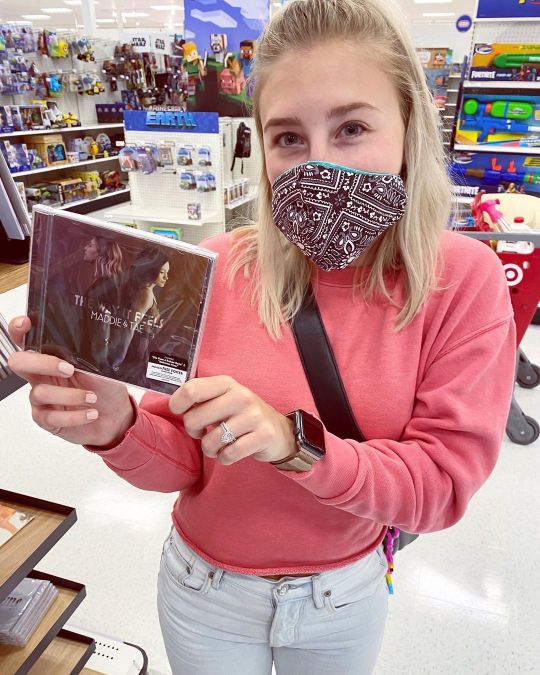
maddieandtae: Finally bought our second album at @target, face mask and all! The Way It Feels is a tangible reminder to me that God is truly a way maker and His timing is perfect. My prayer over this album is that it gives you a song, or 15, that you need to hear when you need to hear it. 🤍 big love -M
2 notes
·
View notes
Photo
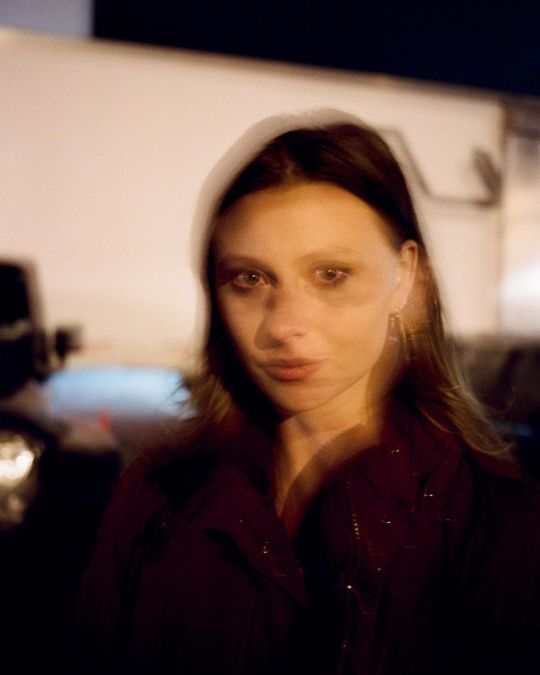
iamaly: Taken right after wrapping our final episode of #iZombie ever....yes I was crying 📷 @auhasardspr
3 notes
·
View notes
Text
Oasis - Wonderwall
1995
"Wonderwall" is a song by English rockband Oasis, written by lead guitarist and chief songwriter Noel Gallagher. The song was produced by Gallagher and Owen Morris for the band's second studio album (What's the Story) Morning Glory?, released in 1995.
The song was released as the fourth single from the album on 30 October 1995. "Wonderwall" topped the charts in Australia and New Zealand and reached the top 10 in 13 other countries, including Canada and the US at number 5 and number 8, respectively, as well as number 2 on both the UK Singles Chart and the Irish Singles Chart. The single was certified septuple platinum by the British Phonographic Industry (BPI) and 11-times platinum by the Australian Recording Industry Association (ARIA). Its music video was directed by Nigel Dick and won British Video of the Year at the 1996 Brit Awards.
In Australia, it was voted number 1 on the alternative music radio station Triple J's Hottest 100 of 1995 and "20 Years of the Hottest 100" in 2013. In May 2005, "Wonderwall" was voted the best British song of all time, in a poll of over 8,500 listeners conducted by Virgin Radio. In October 2020, it became the first song from the 1990s to reach one billion streams on Spotify.
"Wonderwall" received a total of 80,2% yes votes!
youtube
4K notes
·
View notes
Text
i can’t believe there was a time where i wasn’t watching two gilmore girls episodes a day every day
#i did take a break at one point i skipped a rewatch from august 2021 to november 2021#there's 153 episodes (i don't rewatch ayitl) so watching the show from the first episode to the last takes me 11 weeks (2 months and a half#) i start a rewatch every first week of february/may/august/november and i spend twoweeks after each rewatch not watching#and then i'm back again#i've been doing this since i first watched the show in may 2020 i'm watching it for the10th time rn#i'm at the end of season 5#rory's gonna become a criminal soon#gilmore girling
1 note
·
View note
Text
COVID-19's long-term effects on the body: an incomplete list
COVID’s effect on the immune system, specifically on lymphocytes:
NYT article from 2020 (Studies cited: https://www.biorxiv.org/content/10.1101/2020.05.18.101717v1, https://www.biorxiv.org/content/10.1101/2020.05.20.106401v1, https://www.unboundmedicine.com/medline/citation/32405080/Decreased_T_cell_populations_contribute_to_the_increased_severity_of_COVID_19_, https://www.medrxiv.org/content/10.1101/2020.06.08.20125112v1)
https://www.biorxiv.org/content/10.1101/2022.01.10.475725v1
https://www.science.org/doi/10.1126/science.abc8511 (Published in Science)
https://www.ncbi.nlm.nih.gov/pmc/articles/PMC9057012/
https://www.forbes.com/sites/williamhaseltine/2022/04/14/sars-cov-2-actively-infects-and-kills-lymphoid-cells/
https://www.cleveland.com/news/2022/10/in-cleveland-and-beyond-researchers-begin-to-unravel-the-mystery-of-long-covid-19.html
SARS-CoV-2 infection weakens immune-cell response to vaccination: NIH-funded study suggests need to boost CD8+ T cell response after infection
https://www.merckmanuals.com/professional/hematology-and-oncology/leukopenias/lymphocytopenia
https://thetyee.ca/Analysis/2022/11/07/COVID-Reinfections-And-Immunity/
Dendritic cell deficiencies persist seven months after SARS-CoV-2 infection
https://www.frontiersin.org/articles/10.3389/fimmu.2022.1034159/full
https://www.n-tv.de/politik/Lauterbach-warnt-vor-unheilbarer-Immunschwaeche-durch-Corona-article23860527.html (German Minister of Health)
Anecdotal evidence of COVID’s effects on white blood cells:
https://twitter.com/DrJohnHhess/status/1661837956875956224
https://x.com/TristanVeness/status/1661565201345564673
https://twitter.com/TristanVeness/status/1689996298408312832
Much more if you speak to Long Covid patients directly!
Related information of interest:
China approves Genuine Biotech's HIV drug for COVID patients
COVID as a “mass disabling event” and impact on the economy:
https://www.ctvnews.ca/health/report-says-long-covid-could-impact-economy-and-be-mass-disabling-event-in-canada-1.6306608
https://x.com/inkblue01/status/1742183209809453456?s=20
COVID’s impact on the heart:
https://www.dailystar.co.uk/news/world-news/deadly-virus-could-lead-heart-31751263 (Research from: Japan's Riken research institute)
https://www.brisbanetimes.com.au/national/queensland/unlike-flu-covid-19-attacks-dna-in-the-heart-new-research-20220929-p5bm10.html
https://www.mdpi.com/2077-0383/12/1/186
https://medicalxpress.com/news/2023-04-mild-covid-effects-cardiovascular-health.html
https://publichealth.jhu.edu/2022/covid-and-the-heart-it-spares-no-one
https://www.bhf.org.uk/informationsupport/heart-matters-magazine/news/coronavirus-and-your-health/is-coronavirus-a-disease-of-the-blood-vessels (British Heart Foundation)
COVID’s effect on the brain and cognitive function:
https://www.openaccessgovernment.org/article/brain-infection-by-sars-cov-2-lifelong-consequences/171391/
https://www.cidrap.umn.edu/covid-19/study-shows-covid-leaves-brain-injury-markers-blood
https://www.theguardian.com/world/2020/jul/08/warning-of-serious-brain-disorders-in-people-with-mild-covid-symptoms
Cognitive post-acute sequelae of SARS-CoV-2 (PASC) can occur after mild COVID-19
Neurologic Effects of SARS-CoV-2 Transmitted among Dogs
https://journals.lww.com/nsan/fulltext/2022/39030/neurological_manifestations_and_mortality_in.4.aspx
https://www.salon.com/2023/06/17/new-evidence-suggests-alters-the-brain--but-the-extent-of-changes-is-unclear/
https://www.scientificamerican.com/article/covid-virus-may-tunnel-through-nanotubes-from-nose-to-brain/
https://neurosciencenews.com/post-covid-brain-21904/
https://www.thelancet.com/journals/lanpsy/article/PIIS2215-0366(22)00260-7/fulltext
https://medicalxpress.com/news/2022-08-covid-infection-crucial-brain-regions.html
https://news.ecu.edu/2022/08/04/covid-parkinsons-link/
Covid as a vascular/blood vessel disease:
https://www.salon.com/2020/06/01/coronavirus-is-a-blood-vessel-disease-study-says-and-its-mysteries-finally-make-sense/
https://www.salon.com/2023/12/27/brain-damage-caused-by-19-may-not-show-up-on-routine-tests-study-finds/
https://www.nih.gov/news-events/news-releases/sars-cov-2-infects-coronary-arteries-increases-plaque-inflammation
https://www.mdpi.com/2077-0383/12/6/2123
https://www.sciencedaily.com/releases/2021/10/211004104134.htm (microclots)
Long Covid:
Post-COVID-19 Condition in Canada: What we know, what we don’t know, and a framework for action
https://www.ctvnews.ca/health/coronavirus/more-than-two-years-of-long-covid-research-hasn-t-yielded-many-answers-scientific-review-1.6235227
https://www.cbc.ca/news/canada/london/cause-of-long-covid-symptoms-revealed-by-lung-imaging-research-at-western-university-1.6504318
https://www.cbc.ca/news/canada/montreal/long-covid-study-montreal-1.6521131
https://news.yale.edu/2023/12/19/study-helps-explain-post-covid-exercise-intolerance
Other:
- Viruses and mutation: https://typingmonkeys.substack.com/p/monkeys-on-typewriters
Measures taken by the rich and world leaders
Heightened risk of diabetes
https://jamanetwork.com/journals/jama/fullarticle/2805461
https://www.nature.com/articles/d41586-022-00912-y
Liver damage:
https://timesofindia.indiatimes.com/city/mumbai/46-of-covid-patients-have-liver-damage-study/articleshow/97809200.cms?from=mdr
tl;dr: covid is a vascular disease, not a respiratory illness. it can affect your blood and every organ in your body. every time you're reinfected, your chances of getting long covid increase.
avoid being infected. reduce the amount of viral load you're exposed to.
the gap between what the scientific community knows and ordinary people know is massive. collective action is needed.
#putting this somewhere at least as reference for... somebody hopefully#covid#disability#y'all. it is bleak out there but some very good people are doing their best to help#we need as many people aware and helping as possible
460 notes
·
View notes
Photo
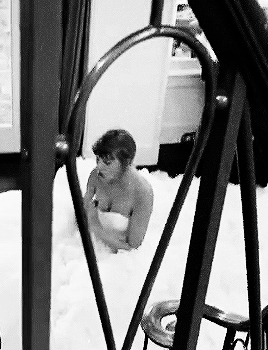
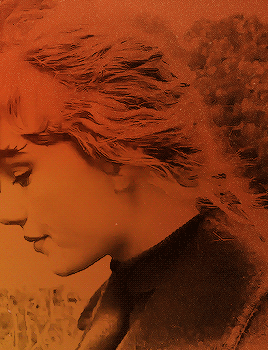



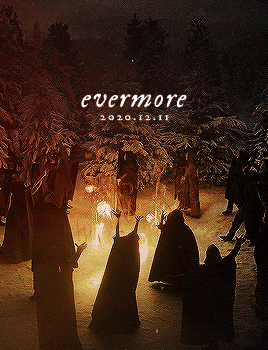


evermore | Taylor Swift [Dec. 11, 2020]
❄🍂🤎
It feels like we were standing on the edge of the folklorian woods and had a choice: to turn and go back or to travel further into the forest of this music. We chose to wander deeper in.
...
I have no idea about a lot of things these days and so I’ve clung to the one thing that keeps me connected to you all. That thing always has and always will be music.
And may it continue, evermore.
#taylor swift#tswiftedit#tswiftgif#evermore#my favorite lil sister turned 2!!!!!!!!!!#Always wish we had more evermore contents :'(
4K notes
·
View notes
Text
Video 📹

Video: dumspirospero67 on Twitter Photo: lulitaflor on Twitter


How the Outlander Season 5 Finale Uses Easter Eggs To Tell Its Story
There were so many references and Easter eggs in the Outlander Season 5 finale.
The Outlander Season 5 finale was much more self-referential than most episodes of this TV show, as we delve into Claire’s subconscious as she dissociates to avoid the reality of her abduction and abuse at the hands of Lionel Brown. Instead of staying in the present, her mind brings her to a 20th century home filled with her 18th century family celebrating American Thanksgiving. The modern house is populated with references to things we have seen Claire experience in previous seasons of this show.
It’s a clever, visually-specific way of telling us about Claire: what matters to her, what she’s afraid of, and what she’s desperately trying to avoid. It is also the kind of episodic writing and direction that wouldn’t work for a less fervid viewership. The creators obviously had faith that fans will have been paying close attention, and the clues to Claire’s past will therefore mean something to them. Let’s break down all of the references and Easter Eggs in the Season 5 finale…
The House Painting
In the dissociation scenes, we see Claire looking at an abstract painting of a house, done in oranges and reds. No, this is not a painting of the house on Fraser’s Ridge on fire, as some people have understandably guessed, but a painting of the house on Fraser’s Ridge totally not on fire.
youtube
The Song
The song playing on the record player during Claire’s dissociation scene is 1967 tune “Never My Love” by The Association. It also gives the episode its name.
The Orange
One of the first Easter eggs in Claire’s dissociation sequence comes in the form of a lone orange, which is a call back to the orange that the King of France gives Claire back in Season 2’s “Faith.”
“After Claire sleeps with the King of France to save Jamie’s life, when she leaves Versailles Palace, the last thing she does is pick up the orange and take it with her,” executive producer Tonia Graphia told Elle. “It was a small gesture by Claire, a choice that symbolizes that she’s leaving with her dignity. Matt and I included it on purpose in Claire’s dream-escapes in 612: The orange being visible in the opening shot in her living room, then, when faced with the choice of whether to kill Lionel in revenge, Claire flashes on the orange—and then her walking out with it—a symbol that she takes the high road. She’s got a piece of herself that no one can ever take from her. We’re hoping the fans who remember the episode in Season 2 will get it!”
The Vase
The vase we see in Claire’s “dream home” is a callback to the very first episode of Outlander. In “Sassenach,” Claire wonders in voiceover how her life might have turned out different if she made different choices, like buying a vase she saw in a shop window.
Strange, the things you remember. Single images and feelings that stay with you down through the years. Like the moment I’d realized I’d never owned a vase. That I’d never lived in any place long enough to justify having such a simple thing. And how at that moment, I wanted nothing so much in all the world as to have a vase of my very own. — Claire as narrator, S01E01 Sassenach
The Dragonfly Toy
At one point in the sequence, a child is playing with a dragonfly toy. The second book in the Outlander book series is called Dragonfly in Amber, as is the final episode of Season 2. Both titles are a reference to the eternal strength of Jamie and Claire’s love. Like a dragonfly in amber, it can withstand even the forces of time (travel).

Claire’s Red Dress
Claire’s bright red dress seems to be a callback to the gorgeous dress that Claire wore in Season 2 when she and Jamie were in France. Or maybe red is just Claire’s power color?
Ian’s Uniform
Ian is dressed in a military uniform in the 20th century dream sequence. This is not a reference to anything that has happened on the show—other than Young Ian leaving home for a long while—but seemingly a reference to the Vietnam War, which would have been going on in late 1960s/early 1970s when this scene seems to be “set.”
While much of Ian’s uniform is a historically accurate U.S. Army uniform, he is wearing a patch on his shoulder that has a silhouette of a Native American, which is a reference to the character’s time with the Mohawk. Also, the medal ribbons are actually made out of Indian wampum beads,” Outlander costumer Trisha Biggar told Town & Country. You can read more about the clever costume choices she made for this sequence via Town & Country.
Jamie’s Outfit
While it might seem like Jamie’s outfit is strictly circa 1770s, Biggar told Town & Country that they made some 20th century adjustments, such as “narrowing down the fullness of the shirt” and “making his breeches look more like a 20th century pair of trousers.”
“Breeches go into the boots, so we just made the trousers go into boots, too,” shared Biggar, “and we made his trousers out of a black denim, so it was a contemporary fabric, but still gave him his 18th century silhouette. He sort of fits in to the 20th century, but is still very much of his own century.”
“You’re Shaking So Hard…”
There were certain lines of dialogue that were direct callbacks to lines of dialogue from earlier seasons. At one point, Dream Jamie says “You’re shaking so hard, it’s making my teeth rattle,” which is something the character said to Claire back in the Outlander premiere.

Murtagh & Jocasta
While Claire doesn’t imagine other deceased loved ones in her dissociation sequence, she does interestingly imagine Murtagh, who died earlier this season, as part of the Thanksgiving Day scene. Murtagh, who mentions Prestonpans at one point in the “day,” is seemingly in a happy relationship with Jocasta, who is noticeably not blind in the sequence. Fergus also seems to have both of his hands, which is also a change from the reality Claire knows.
The Beatles and Ringo Starr
We get several Beatles references within this episode. First, it’s part of dinner conversation during Claire’s dissociation dream. Then, we hear Wendigo Donner use it as a way to confirm that Claire is from the 20th century. He asks her who Ringo Starr is (interesting choice of Beatle), and she tells him that he is a drummer.

The Plaid Blanket
The scene that sees Claire wrapped up in Jamie’s blanket after Jamie has rescued her from Lionel Brown is a call back to the scene in the Outlander pilot that sees Claire wrapped up in Jamie’s blanket after he has rescued her from Jack Randall.
Did we miss any Easter eggs? Let us know in the comments below…
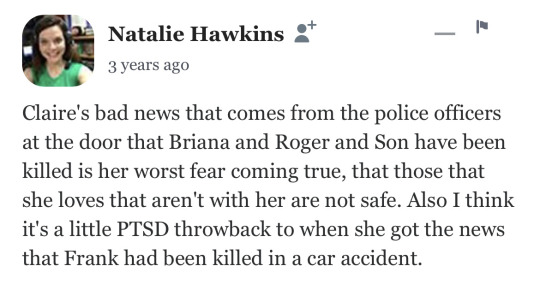

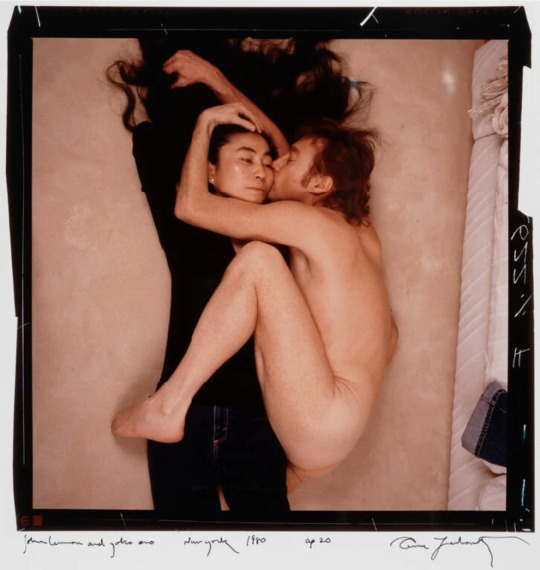
Photo: Annie Leibowitz (provided in comment by Ray Renati)
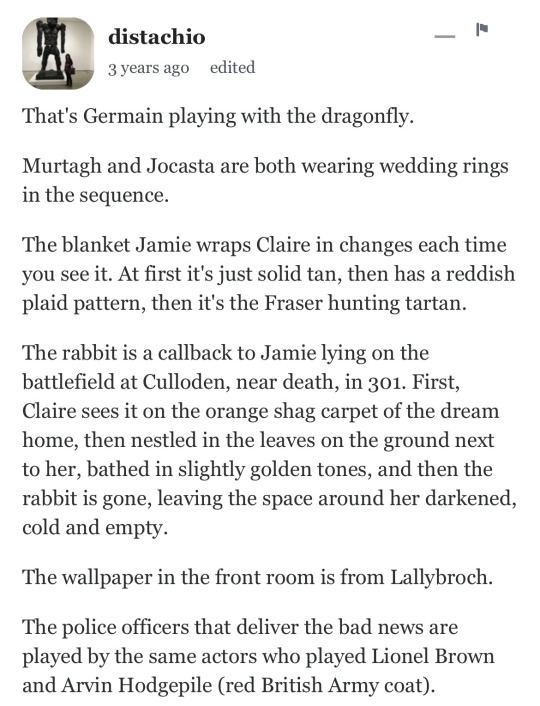
Den of Geek
Remember… for I remember Easter morn, and life and love and peace are all new born. — Alice Freeman Palmer
In the third example in the photo collage, comparing the monstrance to the clock, the monstrance is from the Boston church in S05E05 Perpetual Adoration. Several photos of the monstrance at Blacklanderz
#Tait rhymes with hat#Good times#Easter#Outlander#Easter Eggs#Den of Geek#11 May 2020#S05E12 Never My Love#10 May 2020#Twitter#Youtube#My screenrecording
22 notes
·
View notes
Text
"Parents of tweens will likely be aware of the daily battle over when to give their child a smartphone. They are probably forced into discussing it over breakfast, on the school run, at bedtime – after all, no kid wants to be left out if their friends all have one.
Which is why a town in Ireland came together to devise a solution.
Parents and teachers in Greystones, County Wicklow, launched a town-wide ‘no-smartphone code’ in May, when headteachers from the town’s eight primary schools wrote to parents asking them to sign up to the ban. By coming together en masse, the thinking went, parents could do away with the peer pressure around smartphone ownership.
Now, ministers in the Irish cabinet have approved new guidelines on the banning of smartphones in school, which were brought by education minister Norma Foley on 7 November. The proposals would help parents to collectively implement smartphone bans, with government support. Ministers are also considering outlawing the sale of smartphones to all children of primary school age.
“We can already see smartphones creeping into our primary schools,” explained Rachel Harper, headteacher at St. Patrick’s school, which led on the initiative. “Parents, even at the junior end, were already getting worried about what age their kids were going to be asking for smartphones.”
Parental concerns around the dangers of smartphones are justified, according to the latest scientific research. In 2020, a systematic review of academic studies investigating smartphones, social media use and youth mental health found that, in the last 10 years, mental distress and treatment for mental health conditions had risen in parallel with the use of smartphones by children and adolescents...
There’s also a desire, said Christina Capatina, a Greystones parent whose daughters are aged 11 and nine, to prioritise face-to-face interactions over digital ones for as long as possible. “Childhood is getting shorter,” she said. “It’s really important for them to be in a place where they can be happy and enjoy being out, just being children.”
Parents in Greystones are now empowered to hold off giving their kids access to the devices until the age of 12, when they transition to secondary school in Ireland.
Eight months since the ban came in, what has its impact been? “It has completely solved the problem,” said Capatina. “Instead of having long conversations about it, this is so simple.”
The code is voluntary, so some parents have chosen not to take part, but enough have signed up to create a sense of phoneless-ness being the norm. While some in the media have argued that the code demonises technology, Harper refutes this: “We’re not against technology. We’re not against phones. We’re just simply asking them to wait till secondary school.” [Again, that's age 12 in Ireland.]
She said the launch of their no-smartphone code led to school principals all over the world getting in touch with messages of support, an indication it seems of how universal parents’ fears over childhood smartphone use are.
And with ministers now working on guidelines for communities that wish to follow in Greystones’ footsteps, Harper is proud of all she and fellow parents have achieved. “It’s nice to be an ambassador in a positive way,” she said.
-via Positive.News, November 17, 2023
#smartphone#parenting#primary school#technology#big tech#mental health#teen mental health#ireland#peer pressure#protecting children#good news#hope
417 notes
·
View notes
Text

[ID: Seven yoghurt balls on a plate drizzled with olive oil. The one in the center is plain; the others are covered in mint, toasted sesame seeds, ground sumac, za'tar, crushed red chili pepper, and nigella seeds. End ID]
لبنة نباتية / Labna nabatia (Vegan labna)
Labna (with diacritics: "لَبْنَة"; in Levantine pronunciation sometimes "لَبَنَة" "labanay") is a Levantine cow's, sheep's, or goat's milk yoghurt that has been strained to remove the whey and leave the curd, giving it a taste and texture in between those of a thick, tart sour cream and a soft cheese. The removal of whey, in addition to increasing the yoghurt's tanginess and pungency, makes it easier to preserve: it will keep in burlap or cheesecloth for some time without refrigeration, and may be preserved for even longer by rolling it into balls and submerging the balls in olive oil. Labna stored in this way is called "لبنة كُرَات" ("labna kurāt") or "لبنة طابات" ("labna ṭābāt"), "labna balls." Labna may be spread on a plate, topped with olive oil and herbs, and eaten as a dip for breakfast or an appetizer; or spread on kmaj bread alongside herbs, olives, and dates to make sandwiches.
The word "labna" comes from the Arabic root ل ب ن (l b n), which derives from a Proto-West-Semitic term meaning "white," and produces words relating to milk, yoghurt, nursing, and chewing. The related term "لَبَن" ("laban"; also transliterated "leban") refers to milk in Standard Arabic, but in Levantine Arabic is more likely to refer to yoghurt; a speaker may specify "لَبَن رَائِب" (laban rā'ib), "curdled milk," to avoid confusion.
Labna is a much-beloved food in Palestine, with some people asserting that no Palestinian home is without a jar. Making labna tabat is, for many, a necessary preparation for the winter season. However, by the mid-2010s, the continuation of Israel's blockade of the Gaza strip, as well as Israeli military violence, had severely weakened Gaza's dairy industry to the point where almost no labna was being produced. Most of the 11 dairy processors active in Gaza in 2017 (down from 15 in 2016) only produced white cheese—though Mustafa Eid's company Khalij had recently expanded production to other forms of dairy that could be made locally with limited equipment, such as labna, yoghurt, and buttermilk.
Dairy farmers and processors pushed for this kind of innovation and self-sufficiency against deep economic disadvantage. With large swathes of Gaza's arable land rendered unusable by Israeli border policing and land mines, about 90% of farmers were forced by scarce pasture land and low fodder production to feed their herds with increasingly expensive fodder imported from Israel—dairy farmers surveyed in 2017 spent an estimated 87% of their income on fodder, which had doubled in price since 2007. Cattle were thus fed with low quantities of, or low-quality, fodder, resulting in lower milk production and lower-quality milk.
Most dairy processors were also unable to access or afford the equipment necessary to maintain, upgrade, or diversify their factories. Since 2007, Israel has tightly restricted entry into Gaza of items which they consider to have a "dual use": i.e., a potential civilian and military function. This includes medical equipment, construction materials, and agricultural equipment and machinery, and impacts everything from laboratory equipment to ensure safe food supplies to packaging and labelling equipment. Of the dairy products that Gazan farmers and processors do manage to produce, Israel's control over their export can cause huge financial losses—as when Israel prohibited the export of Palestinian dairy and meat to East Jerusalem without warning in March of 2020, costing estimated annual losses of 300 million USD.
In addition to this kind of economic manipulation, direct military violence threatens Gaza's dairy industry. Mamoun Dalloul says that his factory was accused of holding rockets and subsequently bombed in 2008, 2010, 2012, and again in 2014, resulting in repeated moves and the loss of the capability to produce yellow cheese. The Israeli military partially or totally destroyed 10 dairy processing factories, and killed almost 2,000 cows, during its 2014 invasion of Gaza, resulting in an estimated 43 million USD of damage to the dairy sector alone. Damage to cow-breeding farms in 2014 reduced the number of dairy cows to 2,600, just over half their previous number. Damage to, or destruction of, wells, water reservoirs, water tanks, and the Gaza Power Plant's fuel tank exacerbated pre-existing problems with producing cattle feed and with the transportation, processing, and refrigeration of dairy products, leading to spoiled milk that had to be disposed of. Repeated offensives made dairy processors reluctant to re-invest in equipment that could be destroyed at any time.
Israeli industry profits by making Gazan self-sufficiency untenable. Israeli goods entering Palestine are not subject to import taxes, and Israeli dairy companies are not dealing with the contaminated water, limited electricity, high costs of feed, out-of-date and expensive-to-repair equipment, and scarce land (some companies, such as Tnuva, purchase milk from farms on illegal settlements in the West Bank) with which Gazan producers must contend. The result is that the local market in Gaza is flooded with imports that are cheaper, more diverse, and of higher quality than anything that local producers can offer. Many consumers believe that Israeli products are safer to eat.
Nevertheless, Gazans continue building and rebuilding. Despite significant decreases in ice cream factories' production after the imposition of Israel's blockade in 2007, Abu Mohammad noted in 2015 that locally produced ice cream was cheaper and more varied than Israeli imports. In 2017, the amount of dairy sold in 74 shops in Gaza that was sourced locally, rather than from Israel, had increased from 10% to 60%. Ayadi Tayyiba, the region's first factory with an all-woman staff, opened in 2022; it produced cheese, yoghurt, and labna with sheep's milk from affiliated farms. However, demand for sheep's milk products has decreased in Gaza due to its higher production costs, leading the factory to supplement its supply with purchased cow's milk.
The current Israeli genocidal offensive on Gaza has caused damage of the same kind as—though to a greater extent than—previous shellings and invasions. Lack of ability to sell milk that had already been produced to factories, as well as lack of access to electricity, caused an estimated 35,000 liters of milk to spoil daily in October of 2023.
Support Palestinian resistance by calling Elbit System’s (Israel’s primary weapons manufacturer) landlord, donating to Palestine Legal's activist defense fund, and donating to Palestine Action’s bail fund.
Equipment:
A blender
A kettle or pot, to boil water
A cheesecloth or tea towel
Ingredients:
1 cup (130g) cashews (soaked, if your blender is not high-speed)
3/4 cup filtered or distilled water, boiled
1-3 vegetarian probiotic capsules (containing at least 10 billion cultures total)
A few pinches sea salt
More water, to boil
Arabic-language recipes for vegan labna use bulghur, almonds, or cashews as their base. This recipe uses cashew to achieve a smooth, creamy, non-crumbly texture, and a mild taste like that of cow's milk labna. You might try replacing half the cashews with blanched almonds for a flavor more similar to that of sheep's or goat's cheese.
Make sure your probiotic capsules contain no prebiotics, as they can interfere with the culture. The probiotic may be multi-strain, but should contain some of: Lactobacillus casei, Lactobacillus rhamnosus, Bifidobacterium bifidus, Lactobacillus acidophilus. The number of capsules you need will depend on how many cultures each capsule is guaranteed to contain.
Instead of probiotic capsules, you can use a speciality starter culture pack intended for use in culturing vegan dairy, many of which are available online. Note that starter cultures may be packaged with small amounts of powdered milk for the bacteria to feed on, and may not be truly vegan.
If you want a mustier, goat-ier taste to your labna, try replacing the water with rejuvelac made with wheat berries.
You can also start a culture by using any other product with active cultures, such as a spoonful of vegan cultured yoghurt. If you have a lot of cultured yoghurt, you can just skip to straining that directly (step 5) to make your labna—though you won't be able to control how tangy the labna is that way.
Instructions:
This recipe works by blending together cashews and water into a smooth, creamy spread, then culturing it into yoghurt, and then straining it (the way yoghurt is strained to make labna). It's possible that you could skip the straining step by adding more cashews, or less water, to the yoghurt to obtain a thicker texture, but I have not tested the recipe this way.
1. If your blender is not high-speed, you will need to soak your cashews to soften them. Soak in filtered or distilled water for 2-4 hours at room temperature, or overnight in the fridge. Rinse them off with just-boiled water.
2. Boil several cups of water and use the just-boiled water to rinse your blender, tamper, measuring cups, the bowl you will ferment your yoghurt in, and a wooden spoon or rubber spatula to stir. Your bowl and stirring implement should be in a non-reactive material such as wood, clay, glass, or silicone.
3. Make the yoghurt. Blend cashews with 3/4 cup just-boiled water for a couple of minutes until very smooth. Transfer to your bowl and allow to cool to about skin temperature (it should feel slightly warm if dabbed on the inside of your wrist). If the mixture is too hot, it may kill the bacteria.
4. Culture the yoghurt. Open the probiotic capsules and stir the powder into the cashew paste. Cover the bowl with a cheesecloth or tea towel. Ferment for 24 hours: on the countertop in summer, or in an oven with the light on in winter.
Taste the yoghurt with a clean implement (avoid double-dipping!). Continue fermenting for another 12-24 hours, depending on how tangy you want your labna to be. A skin forming on top of the yoghurt is no problem and can be mixed back in. Discard any yoghurt that grows mold of any kind.
5. Strain the yoghurt to make labna. Place a mesh strainer in a bowl, making sure there's enough room beneath the strainer for liquid to collect at the bottom of the bowl; line the strainer with cheesecloth or a tea towel, and scoop the cultured yoghurt in. Sprinkle salt over top of the yoghurt. Fold the towel or cheesecloth back over the yoghurt, and add a small weight, such as a ceramic plate or a can of beans, on top.
You can also tie the cheesecloth into a bag around a wooden spoon and place the wooden spoon across the rim of a pitcher or other tall container to collect the whey. The draining may occur less quickly without the weight, though.
Strain in the refrigerator for 24-48 hours, depending on the desired texture. I ended up draining about 2 Tbsp of whey.
6. If not making labna balls: Put in an airtight jar, and add just enough olive oil to cover the surface of the labna. Store in the fridge for up to two months.
7. To form balls (optional): Oil your hands to form the labna into small balls and place them on a baking sheet lined with parchment paper. They may still be quite soft.
Optionally sprinkle with, or roll in, dried mint, za'tar, sesame seeds, nigella seeds (القزحة), ground sumac, or crushed red chili pepper, as desired.
Optionally, for firmer balls, lightly cover with another layer of parchment paper and then a kitchen towel, and leave in the refrigerator to dry for about a day.


Place labna balls in a clean glass jar and add olive oil to cover. Retrieve labna from the jar with a clean implement. They will last in the fridge for about a year.

534 notes
·
View notes
Text


evermore | December 11, 2020. I have no idea what will come next. I have no idea about a lot of things these days and so I've clung to the one thing that keeps me connected to you all. That thing always has and always will be music. And may it continue, evermore.
#taylor swift#evermore#tswift#tswiftedit#gifs#mine#tscreators#tscreatorsnet#userelena#userpersy#usermorgan#usersteen#rogerhealey#usereste#tusermelissa#zaniswift#thingschanged#userkarolina#uservivaldi#userabs
358 notes
·
View notes
Photo


SABRINA CARPENTER via Twitter (May 11, 2020)
#sabrina carpenter#scarpenteredit#sabrinacarpenteredit#usermusicdaily#popularcultures#dailywomen#femaledaily#userladiesblr#usersource#useroptional#chewieblog#userbbelcher#userluhra#userchristie
446 notes
·
View notes
Text
I'm definitely going to downsize the account with the intent of eventually deleting it—Pinterest has been a thorn in my side for years. However, I do have some big collections of quotes, creative ideas, character face claims, and other things there that I feel are useful.
First collections to go will be the external links & resources since many are dead or weren't good to begin with. I will keep those up until end of this poll (week) for anyone who wants to fave them.
Collections on the immediate chopping block are linked below!
Also, in part, I would like to remove as much art from my inactive accounts as possible. I know I can't stop Big AI from scraping Pinterest, but I can at least not leave a ton of unprotected (and often uncredited) stuff out in the open. It's simply a sentimental thing at this point.
Save whatever you want and support the artists if you can!
#writing#writers on tumblr#writeblr#last chance#pinterest#poll#writing links#writer resources#writing poll#writing resources#writing inspiration
264 notes
·
View notes